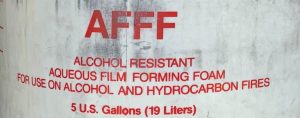Understanding foam part 1
So we all kind of know it by now: AFFF will go away and we will all use fluorine-free firefighting foams one day. We also know that a transition isn’t easy and that AFFF has some unique properties that SFFF cannot achieve. That is why we look at the foam manufacturers to see what they come up with and we hope (or expect) it would suit all our needs. Something as good and as easy to use as AFFF. A drop-in replacement. I don’t believe that is going to happen. The performance of fluorine-free foams has improved. We are seeing better results in extinguishment times and burnback performance. We are also getting foam concentrates with 1% proportioning rates and lower viscosities than five years ago. The tests results when comparing foam concentrates from different manufacturers are not that far apart anymore. But a drop-in replacement? Hasn’t happened yet.
What is the application rate?
The L Curve and the real world
The L Curve looks unimpressive, but the fact that the relationship between extinguishment time and application rate is not linear is of great importance in practice. In other words: Your experience will tell that the curve is right. Some examples: In any fire you need to maintain the minimum application rate or the foam attack will fail. Fortunately it is very low. Typically around 2L/min/m² (0.05gpm/ft²) in our simple example with gasoline and a good performing foam (applying foam by sprinklers requires generally higher application rates than used in the examples here, but that is a different story). The gradient of the curve is negative and quite low at this point. A small increase in the application rate will give you a big benefit in extinguishment time. Applying rates from standards like NFPA 11 or EN 13565 ensure that you have some safety margin to the critical application rate. If you calculate how much foam you have used in a real fire, you will find in most cases that you overshot. You have probably used way more foam than what was actually needed. Most likely this is somewhat unavoidable. But it is important to understand that at already high application rates, you will not get a much faster extinguishment by applying even more foam (the gradient of the curve at this point is still negative but has a smaller value). If you have a big fire and you are at the end of the capability of your equipment, you are going towards the critical application rate and it will take more time to put the fire out.
Comparing AFFF and SFFF
If you use a different foam concentrate you would get a different L Curve. And the same is true if you change other parameters like the fuel for example. This is where it gets really interesting, because you can compare the extinguishment performance of two foams. Any two foams really, but for the sake of this example it should be an AFFF and a fluorine-free foam. Take a look at figure 2. The better performing foam concentrate has an L Curve that is shifted to the lower left side. Faster extinguishment at lower application rates. Let’s assume this is the AFFF. You could argue about this. Some say that the L Curves (or the extinguishment performance) of AFFFs have shifted to the upper right side with the transition from C8 to C6 foams. The L Curves of SFFF have shifted to the lower left side in the past years for sure. Their performance has increased. Have they passed the AFFF L Curve? Or are they very close at least? That’s a bit too much detail for this article…
But if you compare the two foams, it depends at which point you do that. At point A fluorine-free foam might be below its critical application rate. So without doing any other tests and without giving the full L Curve one could claim that “only AFFF did the job”. At point B you will get a big difference between the two foams and one could still argue that “AFFF is far better than fluorine-free foam”. But if you increase the application rate even more (point C), the differences between the two foams get smaller up to a point where you would hardly notice a difference during a real fire.
Application rates in tests and in the real world
Is the performance gap between AFFF and SFFF overrated?
So can it be that the performance gap between AFFF and SFFF is systematically overrated in test setups? Some test reports fail to acknowledge the influence of this at all. The FAA, for example, published their test results on 2 AFFF and 7 SFFF in a report in 2022. They conclude that “None of the FFFs evaluated had an equivalent or better extinguishing performance to AFFF.” (Casey and Trazzi 2022: 88). But they did not discuss the application rate once. Instead they choose foams rated ICAO Level B and tested them according to performance Level C. But the only difference between these two levels according to ICAO is the application rate. It is 2.5L/min/m² for performance level B and 1.56L/min/m² for level C. So it is no surprise that an ICAO Level B foam concentrate fails with an ICAO level C application rate. That is exactly why it is (only) rated level B. As a practical application rate ICAO recommends rates of 5.5 L/min/m² (for level B foams) and 3.75L/min/m² (for level C foams). Tests like these are welcomed by fluorosurfactant manufacturers and their lobbyist (Willson 2022), but hardly bring a fair comparison between AFFF and fluorine-free foams or help to gain a fair understanding on how they perform.
Manipulate Design your own test
You want to do some tests of fluorine-free foam yourself? Do you prefer AFFF or SFFF to look good? For AFFF choose a very low application rate like 1.6L/min/m² (0.04gpm/ft²). For SFFF choose a higher rate. 6.5L/min/m² (0.16gpm/ft²) or even 10L/min/m² (0.25gpm/ft²) for example. If you only present these results and don’t show the extinguishment times from tests at other application rates, you can support your own opinion.
However, I don’t want to say that fluorine-free foams are automatically as good as AFFF in extinguishment performance as long as you choose a high application rate. There might still be an advantage of AFFF over SFFF and there are other factors to consider than just the extinguishment performance. But at practical application rates the gap is most likely much smaller than at those used in many tests.
Getting the full L Curve means a lot of repeats with different application rates. That is why not all test programs can afford to test at different application rates in addition to the other parameters they want to change. But the next time you are reading a test report, look at the application rate and keep the L Curve in mind.
This article was first published in “The Catalyst” Q1 2023
Casey, J. and Trazzi, D. (2022) Fluorine-Free Foam Testing.
Fiala, R. (1985) Untersuchungen Zur Optimierung des Brandschutzes in Großtanklägern.
Willson, M. (2022) ‘Nineteen PFAS-Free Foams (F3S) Failed ICAO Level C and US Milspec Testing: Prompting Public Safety Concerns’. The Catalyst 34–37


